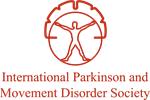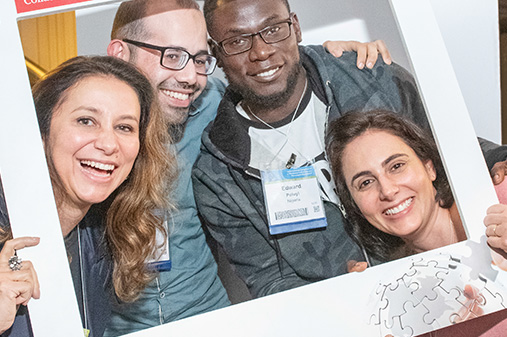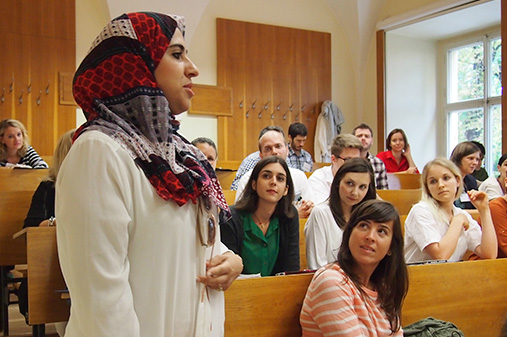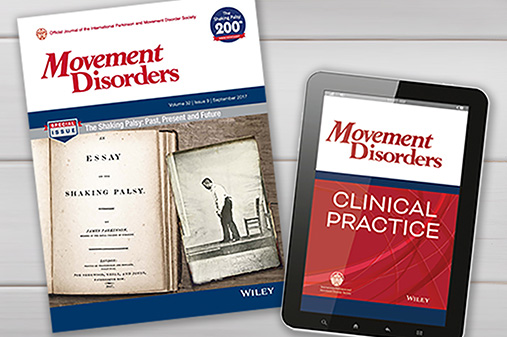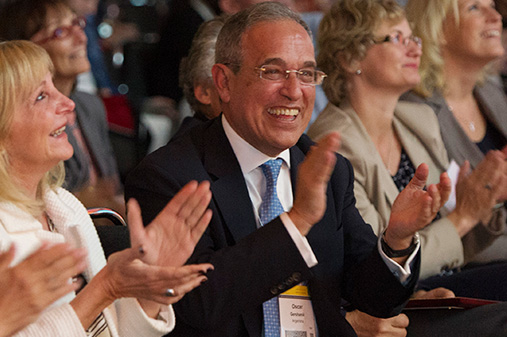Junior Awardee: Identifying a subthalamic nucleus cell subtype responsible for motor benefit in a Parkinsonian mouse model | Congress 2025
Dr. Mitra Afshari: Hello and welcome to the MDS Podcast, the official podcast of the International Parkinson and Movement Disorder Society. I'm Mitra Afshari, an associate editor of the podcast series and your host today. Each year, our society celebrates the groundbreaking research of a select few of its junior members, 40 and under, whose work really rises to the top amongst hundreds of abstracts that are submitted for the annual Congress.
View complete transcript
Today I'm thrilled to be joined by one of our outstanding awardees to share their research with you, especially for those who may not be able to join us in Hawaii live. Dr. Jung Hwan Shin, it's a pleasure to have you here and congratulations.
Dr. Jung Hwan Shin: Thank you very much. Thank you very much. I'm so excited to be here.
Dr. Mitra Afshari: Wonderful. Dr. Shin and I were actually in the MDS Leap class of 2022. And [00:01:00] it's really such a joy to see you shining in your work and being recognized for all of your efforts. Jung, could you tell us a little bit about yourself and your training and where you are at in your career? Tell us a little bit about your residency and fellowship and who your mentors were in movement disorders.
Dr. Jung Hwan Shin: Again, thank you very much. It's really honor to be here in the podcast. I have never thought that I would receive this junior award. I think I am currently dreaming. And thank you for the introduction. I graduated medical school in Seoul National University.
I was born in Seoul, Korea, and I finished my neurology residency and fellowship training in the same hospital, Seoul National University Hospital. My mentor in movement disorder is Professor bj, probably you may all well know. I was very excited and to pursue the career as a clinical neurologist.
My [00:02:00] research that I submitted in this International congress of MDS was actually has to do with the why I started the neurology in the first place. As I was a student, I wasn't a really a fan of neurology, to be honest.
And when I was doing the interns, I was intern at the neurosurgical department and one day I saw this deep brain stimulation surgery. Back then we did the wakeup surgery. It means that we woke the patients up during the DBS surgery. And there was a neurological fellow in the movement d isorders who rated the rigidity tremors, the fellow she talked to the patient. And, that was the moment I got really impressed. I was really shocked to see those amazing surgery that we could do on a patient. So at that time, I decided to do [00:03:00] neurology, I decided to do something similar to this.
And I think that was the start of everything. So I wanted to see which professors or mentors that I should discuss about my future. And there was professor bj, so that's why I started the neurology and that's why I got into this movement disorder fellowship training at the same hospital.
Now I'm currently working as an assistant professor at the Seoul N ational University Hospital, and I'm seeing the patients with DBS. Which is also a dreams come true moment because, the experience that I had as an intern those memory were unforgettable. I kept thinking about it dream work when I got home.
I need to do something similar to that. So yeah, that would be the summary of my career as a clinical neurologist.
Dr. Mitra Afshari: That's really wonderful, Jung. I think all DBS [00:04:00] doctors tend to have one of those aha moments where they see DBS and they say to themselves, that's what I wanna do. But it's always wonderful to hear someone's story in their own words. Right now, how do you currently split your time between clinical work and research?
Dr. Jung Hwan Shin: That's a difficult question. I think that's an ongoing struggle. I usually in five weekdays I do two days of clinical work, mainly on the outpatient clinic, including the DBS clinic, botox, and seeing the movement disorder patients. And three days I try to spend the whole time at my laboratory.
But this is not easy. It couldn't be like two days of a clinical work, three days of a lab which overlaps, within a day. But I think the important thing is to have a time that you could focus on the laboratory work during this clinical duties. So that'll be overall the time that [00:05:00] I spent between this clinical and research.
Dr. Mitra Afshari: Gotcha. Yeah. It's always a hard balance to being a clinician scientist. At the Congress in Hawaii, you'll be receiving one of two junior awards for your abstract entitled, cell type specific bidirectional modulation of STN neurons, rescue Parkinsonian motor symptoms. So this is really interesting, Jung.
So there's still a lot that we don't know about how deep brain stimulation and neuromodulation works, right? There's a lot of theories backed up by basic science work out there and perhaps there's not a single pathway. So your work is really contributing to the growing body of literature that w ith respect to the mechanism of action of DBS. First off, tell us how this work, how many weeks, months, or years of work does this represent in your lab?
Dr. Jung Hwan Shin: I would say, probably about three years of [00:06:00] work in my lab. As you mentioned, yes, we still don't know how DBS works exactly. This let me devote myself into the PhD program, full-time PhD program. When I finished finished my neurology residency, I really wanted to learn more about the mechanism of action in deep brain stimulation.
However, at that time after just at the time that I finished my resident training I found that DBS works really efficient and powerful for everybody at that moment, I thought the DBS working really well, so maybe we do not wanna know more about the mechanism of action because it is already working very well.
Why should we study a little bit more? But at that time as I've been more involved into the DBS programs, I found that would not be the case for everyone. Some patients suffer from the side effects, but I was particularly more interested into the non-motor side effects [00:07:00] of the PD patients having STN DBS, bilateral STN DBS, they might suffer from cognitive side effects, mood side effects. So I found that many patients suffer from those unwanted side effects after DBS. So that's why I decided to learn a little bit more about the DBS, maybe in the more basic science way.
I talked to my mentor professor BJ about, I think I should do the basic science in the neurophysiology using the mouse animal model. I was quite worried what professor BJ would say, he was happy, he was so happy that, I have the interest for the basic science.
So I went to the other university in South Korea, Korea Advanced Institute of Science and Technology, it's MIT in South Korea. So I did the full-time PhD on the basic science using, optogenetics chemo genetics single unit recording [00:08:00] electrophysiology.
And I learned how the tools that needed to study mechanism of basal ganglia. Yeah. So after coming back after the PhD I started as a movement disorder fellow and I had the chance to see more DBS patients and that inspired me to do mechanism action studies on animal models regarding to the deep brain stimulation.
Dr. Mitra Afshari: Wonderful. Can you guide us through what you did in the experiments that led to the results of the study? It seems like you were able to identify a specific subpopulation of cells in the subthalamic nucleus that responsible for the motor benefit scene with STN stimulation. Am I interpreting that correctly?
Dr. Jung Hwan Shin: Yes. That's the heart of my study. This idea is related to the general atmosphere of our field today. For example, if we [00:09:00] say Parkinson's disease, everybody says the Parkinson's disease is not a single disease entity, right? Everyone's talking about Parkinson's heterogeneity of the Parkinson's disease.
There are many subtypes. So I think one of the key questions in our field is that what we thought was like homogeneous single entity. It's not that homogeneous anymore. That idea was applied to the STN actually. Looking back into the neuro physiology studies of the STN,
you'll see that the neurons within the STN is also very heterogeneous. It is composed of various types of neurons in terms of electrophysiology receptors and transcriptomes. So that led to me hypothesis that if STN is so heterogeneous, then we may able to find more specific neuro circuits that's responsible for the Parkinson's disease.
And [00:10:00] that was my initial hypothesis and idea.
Dr. Mitra Afshari: And so the cells that you decided to focus on and were at the heart of your hypothesis, were the, I'm not sure if I'm pronouncing it correctly, but the parvalbumin cells or the PV neurons. Is that correct?
Dr. Jung Hwan Shin: Yes, it's parvalbumin neurons and you'll be quite interested how I got interested into those specific cell types. Initially it w as not directly targeted to the parvalbumin. I had this idea of the heterogeneous neural populations within STN and one of my colleagues,
I did the study about this finding establishing a map of these different cell populations within STN. And that study was published about two years ago, and I was involved in the study before it got published, and I could see the spatial distribution of these different cell types.
[00:11:00] And this parvalbumin neurons captured my mind because the parvalbumin neurons within the STN were distributed in dorsal lateral part of the STN. Which is considered as a hotspot in DbS in many clinical studies, right? I got the feeling that parvalbumin might be the neurons a little bit more specific to the more symptoms of Parkinson's disease.
And I get more information and more data about the parvalbumin neurons that we found that the parvalbumin neurons show the burst firing pattern. More burst firing pattern compared to the STN neurons that doesn't express parvalbumin. So that's another indirect evidence that this parvalbumin neurons might be more specific to the motor features of the Parkinson's disease as the motor symptom of Parkinson's disease correlates really well to this beta burst.
So possibly we [00:12:00] think of the electrophysiological signature of Parkinson's disease as this increased burst activity of the STN output. That also backed our hypothesis by those electrophysiological terms. And also there is an old paper that was published in 1990s by Professor Glenda Halliday and her colleagues, and even in humans parvalbumin neurons are distributed in dorsal lateral part of the STN. All of those background data and publications added up. I first focused on the specific neural subpopulation within the STN.
Dr. Mitra Afshari: That's wonderful and it really highlights like your collaborative spirit and also how fun science is. Things can make sense sometimes, right?
Dr. Jung Hwan Shin: Right. You get chills, sometimes you get goosebumps, you know when everything adds up together.
Dr. Mitra Afshari: Exactly, exactly.
Jung, so you use optogenetics to emulate stimulation. Can you [00:13:00] tell us a little bit about how optogenetics works in simple terms? I think a lot of us are familiar with optogenetics, but can you refresh our memories?
Dr. Jung Hwan Shin: Yes. This optogenetic tool has been developed, I think it's more than about 20 years now.
So this is basically using the opsins that are responsive to certain wavelength of light. For example the general opsin, which is like a prototype of this optogenetic tool, is that if you give a blue light then this opsin responds to this specific light, and the channel is open for a calcium channel, sodium channel.
So we can make the specific neuron fire active. So the powerful aspect about this technique is that we can express this opsin in specific neuronal subtypes that we want. [00:14:00]
So for example, I use the albumin-cre mouse, which is a transgenic mouse model. So this mouse model cre recombinase is only expressed in neurons with parvalbumin.
So even though we give the high blue light and only the parvalbumin neurons are excited. Other neurons that doesn't express parvalbumin, they're silenced. So in this way using this powerful optogenetic tool, viruses and transgenic mouse model, we can modulate the specific population of neurons that that is of interest.
Possibly without this technique, the cell type specific modulation would not be possible. And actually in my study other than optogenetics, I also used the chemo genetic tool, which is basically have the same idea. However, these neurons that are only responsive to certain chemicals.
[00:15:00] So nowadays these methods are really popular and I think it's almost ubiquitous which is quite essential part when you study this neuro physiology studies using the animal models.
Dr. Mitra Afshari: Wonderful. That was a really great summary. So in your Parkinsonian mice, what tests did you use to measure bradykinesia? I'm assuming you focused on bradykinesia, is that right?
Dr. Jung Hwan Shin: Yes. Initially I targeted the motor symptom of Parkinsonian mouse models. So I used the two types of parkinsonian mouse model first is using the toxin model 6-hydroxydopamine hemi-Parkinsonian model, which is widely used in these studies. And secondly, I used the transgenic PD model, which was also developed by our colleagues in the other institute using, it's called the DAT Paris model. And to test the bradykinesia I use the pole test and [00:16:00] also open field test and also balance beam test and hand grip test. So those four tasks were used to measure the baseline bradykinesia and the modifications using this cell type specific modulation. And also using in the toxin model, I use the apomorphine rotation test to test whether these mouse are really Parkinsonian mice.
Dr. Mitra Afshari: Gotcha. And, are these for those of us who don't really work with Parkinsonian mice, are all of these tests fairly, common when it comes to testing motor symptoms in Parkinsonian mice?
Dr. Jung Hwan Shin: Yes. Actually, 6-hydroxydopamine mouse models are really popular and easy to use. I think it's one of the accessible way to use the Parkinsonian model. And other transgenic PD model, there are several types of Parkinsonian PD model that can be used. For example, a53T alpha [00:17:00] nuclear model is also very widely used.
And nowadays, alpha-synuclein preformed fibral injection models and also AV associated virus harboring those alpha-synuclein models are widely used. So I think we can use various types of Parkinson models nowadays. And, then what model should be used. I think it depends on the objective of the study how will you test for like certain drugs or certain modulations and which model would best fit? Is it toxin models or if you focus on this alpha synuclein pathology then it might be better to use those alpha performed fibral injection models or transgenic mouse models that overexpresses alpha-synuclein.
So I think it's not a simple answer. That was big difficulty and challenge for me when I started this study, bottom line is I use two models.
Dr. Mitra Afshari: [00:18:00] Wonderful. I'm sure that the basic scientists in the audience in Hawaii are going to have many questions as to why you chose the bottles that you chose, and I'm sure it's much more complex than we think it is. Ultimately, Jung, you found that it was the activation of the parvalbumin neurons that improved the motor symptoms in both of your Parkinsonian models, right? And why are these results so exciting? It seemed like it was in keeping with your original hypothesis, but what does this mean ultimately?
And how does this translate in the long run, perhaps in clinic, in the care that we can provide?
Dr. Jung Hwan Shin: Yes. I think that would be the very important questions. While doing the research, we consistently found that modulation both exciting activation or silencing this parvalbumin neurons within the STN rescued Parkinsonian motor symptoms [00:19:00] especially in the pole test or those apomorphine rotation test and so on.
And when we modulate the STN neurons, STN neurons that doesn't express parvalbumin there were no effect actually. And additionally we did this in vivo recording of these two populations, parvalbumin expressing STNs or parvalbumin not expressing STN neurons. And we found that those parvalbumin expressing STN neurons are more really encodes this motor information. On the other hand this non parvalbumin expressing STN neurons were quite more active in a manner of anxiety. So we did the elevated plus maze and other tests, and we are consistently observe that those non parvalbumin neurons within the STN fires more, activates more in response to the anxiety.
This led to our [00:20:00] other hypothesis that, okay, so parvalbumin neurons are more specific to the motor symptoms. However this non parvalbumin neurons within the STNs might be more related to this non-motor effects. This might be the, one of the reason for the, possible non-motor side effects of the STN or DBS.
So I think if we continue our work and maybe it has to be replicated among many groups maybe we can imagine, dream, like next generation deep brain stimulation. For example our current DBS is nonspecific and invasive stimulation of STN, right? So we know where we are targeting, but we don't know the extent of how heterogeneous neuro population that we're dealing with in conventional DBS. So if we move on, if we just dream [00:21:00] about next generation DBS, maybe we can focus specifically modulate only those with the neuro circuits that are responsible to therapeutic effects and avoid stimulation of the unwanted neuro circuits.
So I think, I hope this study might inspire future research regarding this Parkinson motor specific DBS programming. So one might ask, we cannot do optogenetics or we cannot do, chemo genetics stimulation in Parkinson's disease.
And I think that's right. So with our current tools we don't have method to perform this neuron specific modulation in the human. But, when someone asks me those questions, that's the question I ask myself a lot. What are you doing? What are you gonna do with this study?
How will this affect the real clinic, real patients? And my answer is, I think in my time of [00:22:00] practice I hope that those novel, really great techniques will come up. I am really a fan of, you know, the theory of a singularity, right?
According to this theory , the technology will exponentially develop over times. And if we have like this technique that can do cell type specific modulation in human and they would ask us, what circuits should we target? Then we should be ready, right?
We should be ready to answer those question and design this novel way of stimulation.
So I think I'm currently doing this fundamental research of preparing for the next generation deep brain stimulation. This is currently my dream and possibly this will be my lifetime goal as a physician scientist and neurologist in movement disorders.
Dr. Mitra Afshari: That's wonderful, Jung. I [00:23:00] t's just really amazing how you had your own original hypothesis and then you found out more through the research about the anxiety component in the non-motor symptoms. There's really quite fascinating. So it sounds like you're gonna take us one step closer to refining stimulation paradigms, improving the precision of stimulating the right cells to improve our outcomes and reduce stimulating the wrong cells that may lead to side effects.
So what's next for you, Jung? Is there a forthcoming publication of this work? When do you plan on releasing the formal results?
Dr. Jung Hwan Shin: Yes. That's also a really great questions. So currently we have almost finished about the animal studies and currently we're actually drafting the manuscript. So possibly that we'll have this formal publication soon. We'll see. We have to see. And I'm very thrilled and [00:24:00] excited to share this results before publications.
So as all of the listeners to this podcast and everyone in at the MDS would know this, I have to be more fast. I have to publish this as soon as possible.
Dr. Mitra Afshari: I think you have us all hooked and we wanna see what the next season brings for you. This is all fantastic. Dr. Jung Hwan Shin from the Seoul National University Hospital in Korea. Thank you so much for joining us today and really breaking down the concepts of, I'm sure some very complex work into something we can all understand and appreciate.
I really look forward to seeing you continue to shine. I'm proud to call you my colleague. And I really look forward to hearing all of this again at the conference in Hawaii. So just to end our podcast today, Jung, this is again a junior award and I wanted to open it up to you to share some, perhaps some words of encouragement [00:25:00] for some of our young listeners who are on the fence about continuing their research visions. Anything, any messages you would like to send to them?
Dr. Jung Hwan Shin: Oh yes. As I said in the introduction, I've never thought that I would get this junior award at MDS. It was always pleasure to see many great researchers awarded as a junior award. In many MDS conference, I have at the MDS conference for more than 10 years.
It was my dream, actually. This is my dreams come true moment, and I think this would be the same probably similar situation for any young researchers out there. If you have great questions. If you have a passion to pursue it, and if you continue to do that, I think you might get this opportunity like me and, I am also at the very beginning of my career.
So I think this would be like a greatest present [00:26:00] for me. And I know that this junior award is awarded to the researchers of age 40 and younger.
Dr. Mitra Afshari: Yes.
Dr. Jung Hwan Shin: Surprisingly, I'll be 40 at the day I got the reward. So I think
Dr. Mitra Afshari: What a coincidence.
Dr. Jung Hwan Shin: Yeah, that's, I think that's also the great thing.
And, I root for all the young researchers out there. Who is doing the hard work to answer the interesting and great questions. Thank you.
Dr. Mitra Afshari: Wonderful. Jung, the stars are really aligning for you. It was such a pleasure and I really look forward to hearing more in Hawaii, so bye-bye for now. [00:27:00]

Jung Hwan Shin, MD, PhD
Seoul National University
Seoul, Korea
